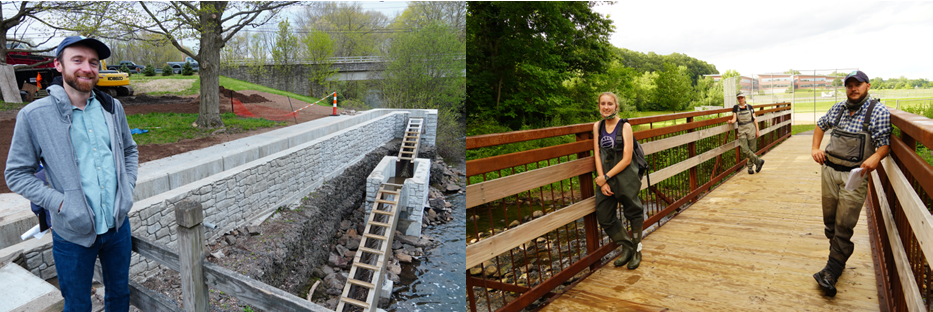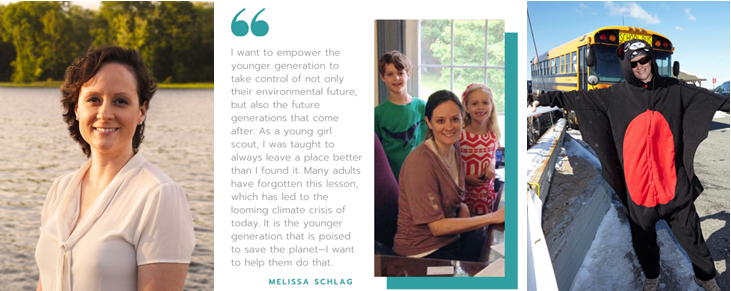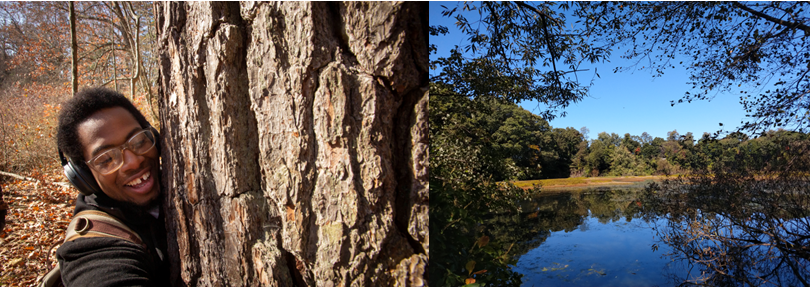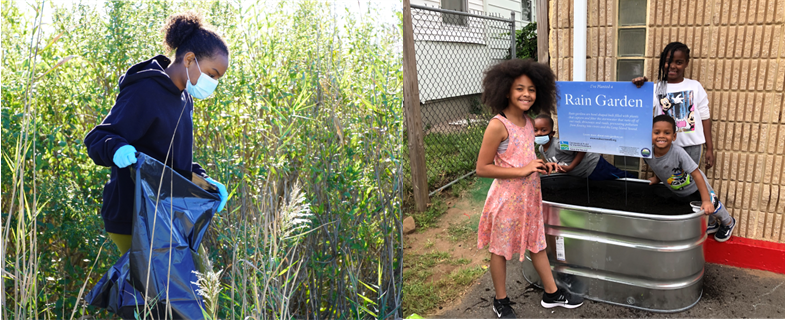
As we look back at 2020, two words keep coming up for our team: resilience and adaptation. They’re approaches we use when dealing with climate change impacts, but they also typify how we’ve approached this tumultuous and momentous year. We’ve had to think on our feet, but weathering hard times has been made easier by know-how, preparation, and a strong team.
We’re grateful for the steady leadership of our board, and the hard work and flexibility of our staff. We’re grateful for the gift of time from volunteers and dedicated interns from area colleges and around the world. And we’re grateful to you reading this: a network of members and activists who choose each year to keep partnering with Save the Sound to advance environmental action.
Walk through the year with us, and see a sampling of what you’ve made possible.
UPHEAVAL AND RECOMMITMENT
New ways of working: The pandemic that has affected so many lives this year also dramatically affected Save the Sound’s work. Starting in mid-March, the majority of our staff has worked from home, adapting programs creatively to keep important efforts moving forward.
And though we couldn’t meet in person for most of 2020, we still found ways to connect with you! This year you joined us at nearly 50 webinars, film club discussions, and online trivia nights, plus outdoor distanced events. We’re especially grateful for the support and enthusiasm you showed as we undertook a name unification process and continue our mission as Save the Sound.

Keeping the fish moving: When COVID-19 hit, many things stopped—but natural systems kept moving, and so did our Ecological Restoration team. Forced to adapt mid-construction, we completed the Pages Millpond Dam fishway, restoring migratory fish passage to 10 miles of habitat in the Farm River watershed in North Branford, CT. We also made great progress on a dam removal at Merwin Meadows Park on the Norwalk River. Meanwhile, our monitoring at past dam removal sites revealed exciting discoveries: American shad and sea lamprey using the restored habitat, and over 400,000 alewife passed the Bride Brook culvert we helped replace a decade ago.
Energy setbacks and winds of change: COVID-19 derailed Connecticut’s legislative session (and with it several pieces of strong climate legislation), and the Court of Appeals rejected our federal court case to stop the state from stealing ratepayer energy efficiency funds. But we didn’t give up. Our Climate and Legal teams are still working to prevent future funds diversions, and working with state agencies to keep Connecticut on track to meet its greenhouse gas reduction goals. Among the clean energy victories we’ve been part of is securing over 800 MW of offshore wind, and working with stakeholders to develop best practices and ensure stringent environmental standards are applied consistently across the region. On the reconstituted Governor’s Council on Climate Change, we now co-chair the Mitigation Strategies working group and serve on others to develop a comprehensive suite of recommendations for Connecticut.

Unifying around water quality: This year’s first annual Black Rock Harbor Water Quality Summit in Bridgeport, organized in February by Peter Spain, Ash Creek Conservation Association, and Save the Sound, is a great example of a community pulling together to address pernicious water pollution challenges. As the pandemic added its own challenges, our water quality team adapted our Sound-wide Unified Water Study to continue safely testing the water in bays all around the Sound, and brought those data and that network of local partners to the public on SoundHealthExplorer.org.
Forms of justice: The murder of George Floyd by police reignited a passionate and widespread demand for justice, and deep reflection into who we are as a nation. At Save the Sound, the Black Lives Matter movement inspired us to reactivate our Diversity, Equity, and Inclusion Committee—now meeting regularly, with subcommittees focused on hiring, cooperative learning, and other action areas. We’re also taking a more deliberate look at our Environmental Justice work, an area of focus for the organization for decades, to ensure we’re choosing and conducting projects in ways that benefit the communities most impacted by unhealthy air, contaminated soils, and lack of economic and nature opportunities. This is an ongoing process, and we expect to continue reporting periodically on our journey.
SHAPING VISIONS
Imagining Plum Island’s future: July saw the culmination of Envision Plum Island, a two-year community process to develop a clear vision for Plum Island’s future and provide the concrete plan Congress and New York State needed to save the island permanently. Over 100 participants, including New York and Connecticut congressional champions, joined virtual events to hear the details.
Sound stories: This year science did the talking, telling the story of progress toward a healthy and vibrant Long Island Sound, and highlighting work yet to be done. Our 2020 Long Island Sound Report Card provided comparable grades for 50 bay segments and the five open water segments of the Sound. The results are mixed, showing the highly local nature of water pollution and highlighting the connection between how we live along our coasts and the health of our coastal waters.

Driving transportation emissions down: The transportation sector is Connecticut’s largest source of greenhouse gas emissions, so transportation solutions are critical to climate success. As convener of the CT Electric Vehicle Coalition we’re pushing the administration to adopt aggressive state EV procurement targets and reinstate meaningful incentives for EV purchase through the CHEAPR program.
New ways to patrol: When not out on the water, Long Island Soundkeeper Bill Lucey can sometimes be found patrolling the Sound from the skies. As a licensed drone operator, Bill uses our Phantom Pro 4 to document environmental conditions from algal blooms to dams. It is highly useful for accessing hard-to-reach locations and creating a record of changing conditions over time.
Standing strong on the laws that protect nature—and you: Recent years have seen numerous attempts to weaken federal environmental protections, and this was no exception. We filed comments opposing rollbacks related to the National Environmental Policy Act, use of public health data in environmental regulations, and factors determining Clean Water Act compliance schedules.
We also helped pass reforms to Connecticut’s major remediation law while assuring oversight and transparency, and are working to bring teeth to Connecticut’s Environmental Justice law.
LOSS AND COMING TOGETHER
Saying goodbye to a loved team member: October brought another blow in this difficult year: the loss of our colleague Melissa Schlag. Melissa was an integral part of our communications, climate, and lands teams at Save the Sound for four years, bringing her quick mind, sharp wit, and political acumen to every project she touched. Her conviction, curiosity, and willingness to share her deep knowledge made her a natural convener of youth climate activists and a mentor to interns. In everything, Melissa was a fierce and tireless advocate for the environment, for transparency, and for free speech. Her impact on Save the Sound, and on each of us, was profound.

Together for reflection and action: Our virtual Annual Meeting in October highlighted the resiliency both you and nature have shown during the pandemic and the important work your continued support has made possible. In spite of a turbulent year, over 4,000 passionate members kept fighting for clean water, battling climate change, and preserving important natural areas. At this year’s meeting we honored the contributions of outgoing Board President Leslie Lee, who has led Save the Sound through five years of growth, and welcomed incoming President Todd Cort.
We began the Save the Sound Leadership Council this year, bringing together many of our major donors for exclusive presentations by experts, strategic discussions, and networking opportunities. The Soundkeeper and Climate Taskforces are providing strategic advice and financial capacity to ensure our programs are strong.
We came together outdoors, too. Our first ever fully virtual fundraising event, Paddle for the Sound, combined social-distance safety with an outdoor thon-style competition. Forty-two environmental advocates from Mount Kisco, NY to Colchester, CT paddled, kayaked, sailed, walked, or ran for a collective 675 miles, raising over $12,500.

Imagining a park for Newhall: This year Save the Sound started working with community organizations to clean up Olin Powder Farm and to open it to the public as a park. This 102-acre gem, with its forest and five ponds, is tucked just north of Newhall in southern Hamden, CT—a neighborhood long plagued by environmental burdens. Neighbors and advocates petitioned CT DEEP to order Olin Corporation to clean up remaining hazardous waste at the site, and in November, the project steering committee met with officials and received assurance they’ll push for remediation.

Sharing the sun: We continue improving Connecticut’s expanded shared solar program, which will add up to 25 MW per year of solar to our clean energy grid, and ensuring it directly benefits residents, prioritizing low and moderate income customers. With the voices of citizen activists like you, we continue to advocate before PURA for rules that will support—not hinder—clean distributed energy resources and the jobs that accompany them (watch video).
Catching the runoff—and the trash: Our Ecological Restoration team completed our residential rain garden program, installing 28 rain gardens over four years in environmental justice communities. All told, these gardens will divert 600,000 gallons of stormwater annually and reduce runoff to the West River in New Haven.
And amidst great uncertainty, nearly 1,500 volunteers turned out for 41 safe cleanups across Connecticut, plus innovative “virtual cleanups.”

Don’t trash The Annex: We are fighting to stop DEEP and the New Haven City Plan Commission from permitting a municipal solid waste facility to expand their operations in the Annex in New Haven, arguably the most environmentally overburdened community in Connecticut. Watch testimony from neighbors.
Down with Kinneytown: Our Ecological Restoration team and Soundkeeper are working with local partners and our Legal team is advocating before FERC—all to require safe, timely, and effective fish passage at the Kinneytown Dam, which singlehandedly blocks the migration of fish from Long Island Sound to over 30 miles of restored habitat on the Naugatuck River.
ENDING ON A HIGH NOTE
Saving the Oswegatchie Hills: Our legal team scored a victory in December when the East Lyme Zoning Commission denied an application by the developer who owns the 236 acres of coastal forest to change the town’s existing regulations and reduce the commission’s ability to require adequate environmental information in a final site plan. The Save Oswegatchie Hills Coalition switched from in-person talks and hikes to social media and virtual tours of the adjoining preserve, highlighting the peaceful beauty of native flora and fauna and the importance of human access to nature and open space.
Growing restoration opportunities: This fall the Ecological Restoration team secured funding to undertake a watershed planning effort on Westchester County’s Hutchinson River and to design a nature-like fishway at Long Pond Dam on Whitford Brook in southeast CT.

Sewage-free Long Island Sound: This has been a huge year for getting sewage out of the Sound. It has been five years since Save the Sound filed our federal lawsuit to get needed repairs and upgrades to failing sewage infrastructure in Westchester’s Sound Shore communities. We’ve now reached agreements with five municipalities, with the result that 500+ miles of municipal sewer lines have been inspected and more than 38,000 defects identified. This year we signed settlements with the Town of Darien in CT and the Village of Rye Brook in Westchester, with more pending.
We participated in Water and Sewer Commission permit proceedings for Springfield, MA, achieving the first ever nitrogen limit on the facility to protect the Connecticut River and Long Island Sound. Our work to ensure New York City, Bridgeport, and the Hartford area’s Metropolitan District Commission address their Combined Sewer Overflows continues, as well.
Regional transportation action for the climate: December brought good news for our region’s air: CT, MA, RI, and DC have joined the Transportation and Climate Initiative! NY hasn’t yet signed on but remains involved. TCI is a regional cap-and-invest program modeled on RGGI, which has been slashing emissions from the electricity sector for 15 years. It’ll help build a cleaner and more efficient transportation system, a stronger state economy, and healthier air for our most overburdened communities.
Big dollars for clean water and healthy habitats: The federal budget passed just a few days before Christmas included a big present for our region: $30.4 million for Long Island Sound. This increase of $9 million over last year shows the commitment and negotiating skill of our great senators and representatives. This will fund the restoration, water quality, climate action and resiliency, conservation, and environmental justice work of Save the Sound and other organizations.
No auction for Plum Island: That same bill contains another huge gift: repeal of the laws directing an auction of Plum Island. After nearly a decade of advocacy, this finally opens the path to permanent protection of this unique place and its critical habitats, endangered wildlife, and cultural history. It couldn’t have happened without the bipartisan leadership of our partners in Congress, the Preserve Plum Island Coalition—and YOU. Years of consistent public outcry drove this effort forward. We can’t wait to work with you on the next steps to find a permanent conservation owner and ensure Plum Island stays in the public’s hands forever.

WITH THANKS AND HOPE
Gifts to keep afloat and chart new courses: Donors who believe in Save the Sound are one of our greatest strengths—the commitment of our close supporters makes it possible for us to take action for our region’s environment. You are fighting for strong climate policies, protecting endangered lands, and keeping our water clean. Thank you all for your generosity and passion!
We received many special gifts for which we are very grateful, including donations to help us stay stable during this pandemic year and two challenge matches which helped motivate hundreds of other donors. Inspiring donations for our legal advocacy team, our water quality lab, Plum Island, and a New York ecological restoration program expansion not only kept our organization funded through the pandemic this year, but are building our strength for the future.
We truly felt that we were ALL in this together. Thank you.
Into the future together: Next year will bring its own challenges and triumphs, and we look forward to tackling them. Please consider joining us as a member if you haven’t already, and make sure you’re part of our email action network, to do that work together.
